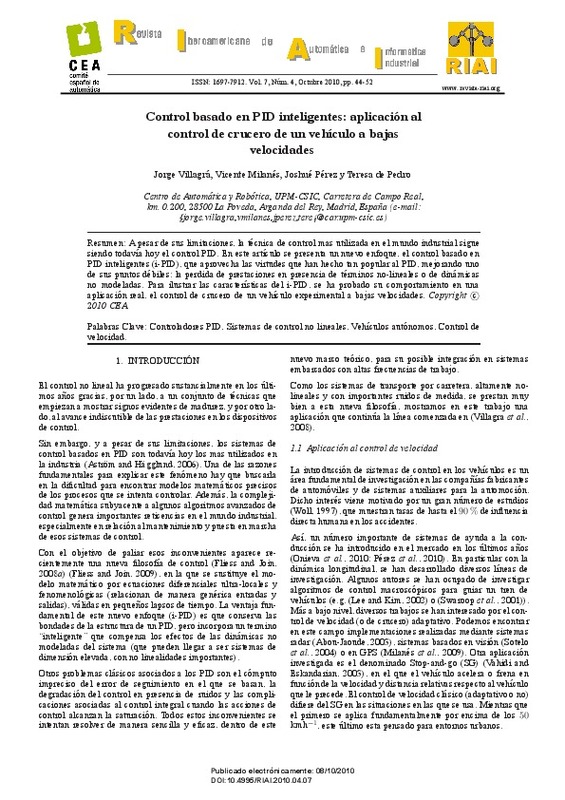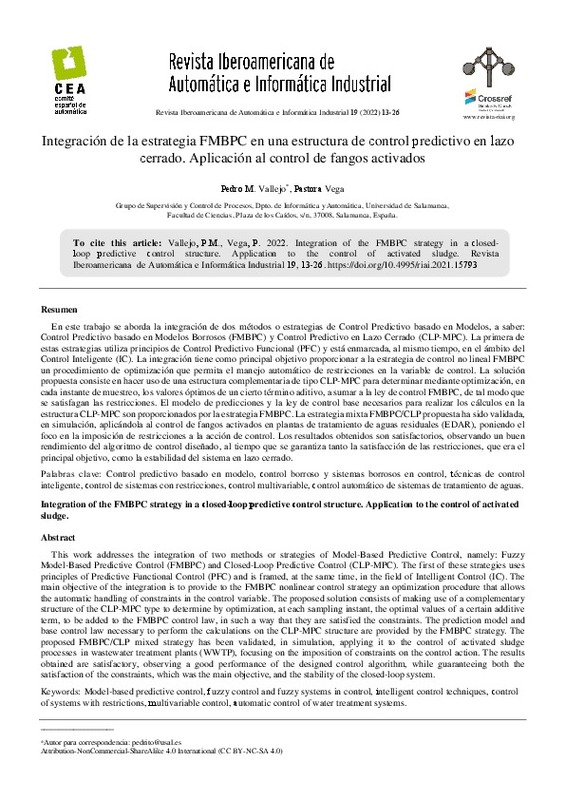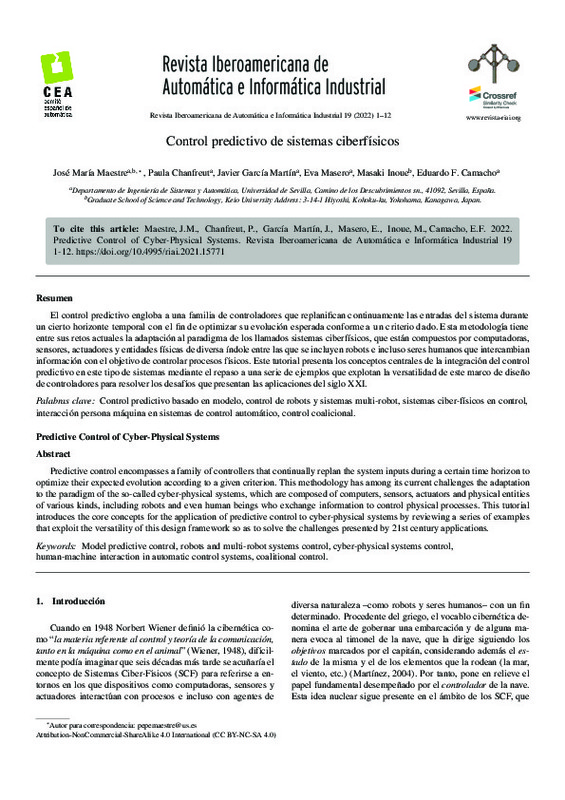JavaScript is disabled for your browser. Some features of this site may not work without it.
Buscar en RiuNet
Listar
Mi cuenta
Estadísticas
Ayuda RiuNet
Admin. UPV
Control basado en PID inteligentes: aplicación al control de crucero de un vehículo a bajas velocidades
Mostrar el registro sencillo del ítem
Ficheros en el ítem
| dc.contributor.author | Villagrá, Jorge
|
es_ES |
| dc.contributor.author | Milanés, Vicente
|
es_ES |
| dc.contributor.author | Pérez, Joshué
|
es_ES |
| dc.contributor.author | de Pedro, Teresa
|
es_ES |
| dc.date.accessioned | 2020-05-29T09:17:55Z | |
| dc.date.available | 2020-05-29T09:17:55Z | |
| dc.date.issued | 2010-10-08 | |
| dc.identifier.issn | 1697-7912 | |
| dc.identifier.uri | http://hdl.handle.net/10251/144616 | |
| dc.description.abstract | [ES] A pesar de sus limitaciones, la técnica de control más utilizada en el mundo industrial sigue siendo todavía hoy el control PID. En este artículo se presenta un nuevo enfoque, el control basado en PID inteligentes (i-PID), que aprovecha las virtudes que han hecho tan popular al PID, mejorando uno de sus puntos débiles: la perdida de prestaciones en presencia de términos no-lineales o de dinámicas no modeladas. Para ilustrar las características del i-PID, se ha probado su comportamiento en una aplicación real, el control robusto de velocidad sobre un vehículo experimental en entornos urbanos. | es_ES |
| dc.description.abstract | [EN] In spite of its limitations, the most widespread industrial control technique is still today PID control. In this article, a new approach, intelligent PID based control (i-PID), will be presented. It takes advantage of its strength, while it improves one of its main weak points: the loss of performance in presence of non-linear terms or unmodeled dynamics. To show the i-PID behavior it has been implemented on a real application, the robust cruise control of an experimental vehicle in urban environments. | es_ES |
| dc.description.sponsorship | Este trabajo ha sido realizado gracias a los proyectos TRANSITO (Coordinación Local entre Vehículos e Infraestructuras), TRA 2008-06602-C03-01; GUIADE (Guiado Automático de Vehículos de Transporte Público mediante Percepción Multimodal para mejorar la Eficiencia), T9/08 y MARTA (Movilidad y Automoción con Redes de Transporte Avanzadas), CENIT-20072006 y CityElec (Sistemas para Electrificación de la Movilidad en ENtorno Urbano), SP01. | es_ES |
| dc.language | Español | es_ES |
| dc.publisher | Universitat Politècnica de València | es_ES |
| dc.relation.ispartof | Revista Iberoamericana de Automática e Informática industrial | es_ES |
| dc.rights | Reconocimiento - No comercial - Sin obra derivada (by-nc-nd) | es_ES |
| dc.subject | Controladores PID | es_ES |
| dc.subject | Sistemas de control no lineales | es_ES |
| dc.subject | Vehículos autónomos | es_ES |
| dc.subject | Control de velocidad | es_ES |
| dc.subject | PID controllers | es_ES |
| dc.subject | Nonlinear control systems | es_ES |
| dc.subject | Robust controllers | es_ES |
| dc.subject | Autonomous vehicles | es_ES |
| dc.subject | Speed control | es_ES |
| dc.title | Control basado en PID inteligentes: aplicación al control de crucero de un vehículo a bajas velocidades | es_ES |
| dc.title.alternative | Intelligent PID based control: an application to robust cruise control in urban environments | es_ES |
| dc.type | Artículo | es_ES |
| dc.identifier.doi | 10.1016/S1697-7912(10)70059-5 | |
| dc.relation.projectID | info:eu-repo/grantAgreement/MICINN//TRA2008-06602-C03-01/ES/COORDINACION LOCAL ENTRE VEHICULOS E INFRAESTRUCTURAS/ | es_ES |
| dc.relation.projectID | info:eu-repo/grantAgreement/MFOM//T9%2F08/ | es_ES |
| dc.relation.projectID | info:eu-repo/grantAgreement/MITURCO//CENIT2007-2006/ES/MARTA. MOVILIDAD Y AUTOMOCIÓN CON REDES DE TRANSPORTE AVANZADAS/ | es_ES |
| dc.relation.projectID | info:eu-repo/grantAgreement/MICINN//PSE-370000-2009-4/ES/Sistemas para la electrificación de la movilidad en entorno urbano/ | es_ES |
| dc.rights.accessRights | Abierto | es_ES |
| dc.description.bibliographicCitation | Villagrá, J.; Milanés, V.; Pérez, J.; De Pedro, T. (2010). Control basado en PID inteligentes: aplicación al control de crucero de un vehículo a bajas velocidades. Revista Iberoamericana de Automática e Informática industrial. 7(4):44-52. https://doi.org/10.1016/S1697-7912(10)70059-5 | es_ES |
| dc.description.accrualMethod | OJS | es_ES |
| dc.relation.publisherversion | https://doi.org/10.1016/S1697-7912(10)70059-5 | es_ES |
| dc.description.upvformatpinicio | 44 | es_ES |
| dc.description.upvformatpfin | 52 | es_ES |
| dc.type.version | info:eu-repo/semantics/publishedVersion | es_ES |
| dc.description.volume | 7 | es_ES |
| dc.description.issue | 4 | es_ES |
| dc.identifier.eissn | 1697-7920 | |
| dc.relation.pasarela | OJS\8461 | es_ES |
| dc.contributor.funder | Comisión Interministerial de Ciencia y Tecnología | es_ES |
| dc.contributor.funder | Ministerio de Fomento | es_ES |
| dc.contributor.funder | Ministerio de Industria, Turismo y Comercio | es_ES |
| dc.contributor.funder | Ministerio de Ciencia e Innovación | es_ES |
| dc.description.references | Abou-Jaoude, R. (2003). ACC radar sensor technology, test requirements, and test solutions. IEEE Transactions on Intelligent Transportation Systems, 4(3), 115-122. doi:10.1109/tits.2003.821286 | es_ES |
| dc.description.references | Bechtel (1993). Compendium of executive summaries from the maglev system concept definition final reports. Technical report. U.S. Department of Transportation. | es_ES |
| dc.description.references | Fliess, M., Join, C., & Ramirez, H. S. (2008). Non-linear estimation is easy. International Journal of Modelling, Identification and Control, 4(1), 12. doi:10.1504/ijmic.2008.020996 | es_ES |
| dc.description.references | Fritz, H. (1996). Neural speed control for autonomous road vehicles. Control Engineering Practice, 4(4), 507-512. doi:10.1016/0967-0661(96)00033-0 | es_ES |
| dc.description.references | Huang, S., & Ren, W. (1999). Vehicle longitudinal control using throttles and brakes. Robotics and Autonomous Systems, 26(4), 241-253. doi:10.1016/s0921-8890(98)00056-6 | es_ES |
| dc.description.references | Hunt, K. J., Johansen, T. A., Kalkkuhl, J., Fritz, H., & Gottsche, T. (2000). Speed control design for an experimental vehicle using a generalized gain scheduling approach. IEEE Transactions on Control Systems Technology, 8(3), 381-395. doi:10.1109/87.845870 | es_ES |
| dc.description.references | Lee, G. D., & Kim, S. W. (2002). A longitudinal control system for a platoon of vehicles using a fuzzy-sliding mode algorithm. Mechatronics, 12(1), 97-118. doi:10.1016/s0957-4158(00)00063-5 | es_ES |
| dc.description.references | Liang, H., To Chong, K., Soo No, T., & Yi, S.-Y. (2003). Vehicle longitudinal brake control using variable parameter sliding control. Control Engineering Practice, 11(4), 403-411. doi:10.1016/s0967-0661(02)00176-4 | es_ES |
| dc.description.references | Mboup, M., Join, C., & Fliess, M. (2008). Numerical differentiation with annihilators in noisy environment. Numerical Algorithms, 50(4), 439-467. doi:10.1007/s11075-008-9236-1 | es_ES |
| dc.description.references | Milanés, V., Onieva, E., Pérez, J., de Pedro, T., & González, C. (2009). Control de Velocidad basado en Lógica Borrosa para Entornos Urbanos Congestionados. Revista Iberoamericana de Automática e Informática Industrial RIAI, 6(4), 61-68. doi:10.1016/s1697-7912(09)70109-8 | es_ES |
| dc.description.references | Pacejka, H. B., & Bakker, E. (1992). THE MAGIC FORMULA TYRE MODEL. Vehicle System Dynamics, 21(sup001), 1-18. doi:10.1080/00423119208969994 | es_ES |
| dc.description.references | Swaroop, D., Hedrick, J. K., & Choi, S. B. (2001). Direct adaptive longitudinal control of vehicle platoons. IEEE Transactions on Vehicular Technology, 50(1), 150-161. doi:10.1109/25.917908 | es_ES |
| dc.description.references | Vahidi, A., & Eskandarian, A. (2003). Research advances in intelligent collision avoidance and adaptive cruise control. IEEE Transactions on Intelligent Transportation Systems, 4(3), 143-153. doi:10.1109/tits.2003.821292 | es_ES |
| dc.description.references | Villagra, J., Novel, B. D., Choi, S., Fliess, M., & Mounier, H. (2009). Robust stop-and-go control strategy: an algebraic approach for non-linear estimation and control. International Journal of Vehicle Autonomous Systems, 7(3/4), 270. doi:10.1504/ijvas.2009.033264 | es_ES |











